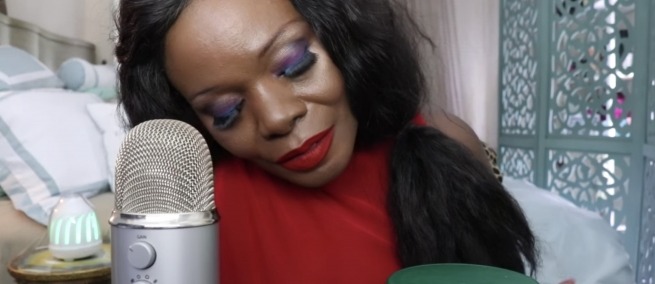
“These pickles are so good,” a woman whispers into a microphone as she unscrews a jar of kosher pickles, long nails lightly tapping the glass, and then slowly takes a crunchy bite. Hit the button marked next on the video monitor for ASMR content at the Museum of the Moving Image and the screen fills with a pair of hands running back and forth over a rug, practically giving it a massage. ASMR is an abbreviation of Autonomous Sensory Meridian Response. The Museum’s current exhibition is called “The New Genres,” and explores the effects of the Internet on moving image content and distribution. Spirit Payton, whose pickle eating video has over 12 million views, is an ASMR artist who posts her original videos to YouTube.
The term ASMR was coined in 2010 by a woman named Jennifer Allen. Allen posted on the web forum steadyhealth.com about a weird, but pleasant, sensation she felt that she wondered if others felt as well. She found a community, and founded a Facebook group dedicated to the phenomenon thereafter. ASMR “describes a pleasant tingling sensation that some people report feeling on their scalp and upper neck when they encounter certain stimuli (or ‘triggers’). Whispering is the most common trigger, followed by personal attention, crisp sounds, and slow movements,” Museum of the Moving Image curator Jason Eppink writes in The New Genres gallery. Self-reports indicate that the ASMR sensation is accompnied by a feeling of relaxation, which can help with stress, anxiety, chronic pain, insomnia, and even P.T.S.D. symptoms.
A subset of the general population reports experiencing ASMR. Videos of Bob Ross hosting the instructional painting series The Joy of Painting, which broadcast in the ’80s and ’90s and is now available on YouTube, is a popular trigger. In a video produced by The New Yorker about ASMR, biopharmaceutical scientist Craig Richard admits that “it was [Bob Ross'] voice, it was him tapping on the canvas. And I would sit on the floor and halfway through his program I would fall asleep.” Though not exactly mainstream, ASMR is gaining attention.
In 2017, the multinational retailer IKEA released a 25-minute video called Oddly Ikea meant to induce ASMR; it currently has close to two million views on YouTube. The video is undoubtedly an advertisement—prices and product dimensions for each item are clearly stated, but they are whispered by a female voice speaking slowly in a hushed tone. Only her arms and hands come into view during the video. Thirteen minutes are spent tucking in sheets and examining the thread count, and the few other activities in the ad include sliding storage boxes in and out of shelves, and tapping nails along a desk lamp.
The IKEA video can be categorized into a comparable genre, “Oddly Satisfying,” which can evoke the ASMR sensation. Oddly Satisfying videos, also in “The New Genres” exhibit, depict “richly colored fluid materials and malleable surfaces, refined motor skills, synchronized motion, and precise arrangements that viewers find inexplicably reward to watch,” according to Eppink. These videos are sometimes set to music tracks rather than to whispered overtones; hands mush and pull Nickelodeon’s neon-colored Gak, or tear parts off of a wet foam block and squish it until it dissolves.
There are theories about why some people experience ASMR. Craig Richard suggests in The New Yorker video that there might be a genetic basis because the opposite condition—misophonia—has been shown by the for-profit genetic testing company 23andMe to have a gene associated. Richard is at the forefront of ASMR researchers, though as he says in The New Yorker video, “no one has been able to unravel the biochemistry or the exact physiological experience that people are having.”
In 2014, Richard launched ASMRUniversity.com where he gathers self-reported data and publishes research findings. A survey that he is running on the site, which has been approved by the IRB Board of Shenandoah University and by the School of Psychology, collects fairly standard biographical data and personality information in an effort to map the demographics of those who experience the phenomenon. It has been running since 2014, and has received over 25,000 responses.
“The New Genres: Video in the Internet Age,” is on view at the Museum of the Moving Image through September 2, 2018.